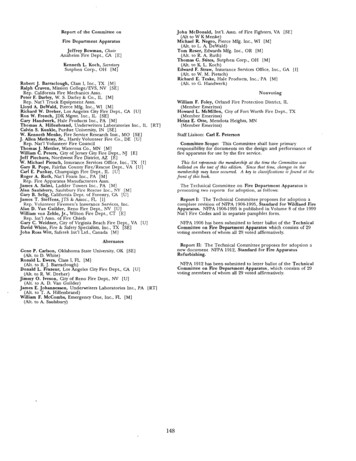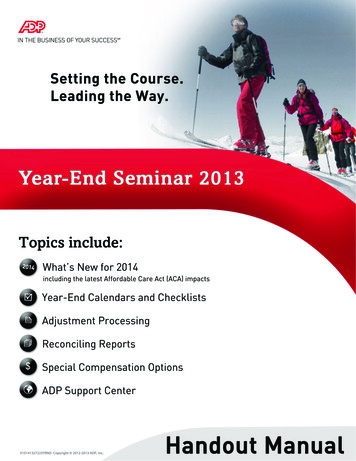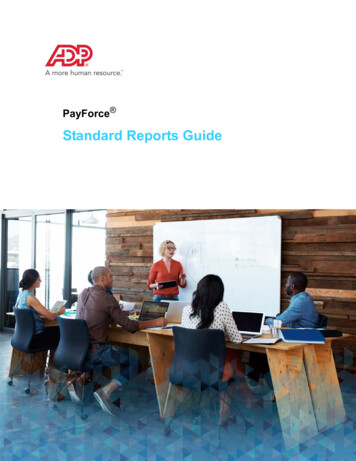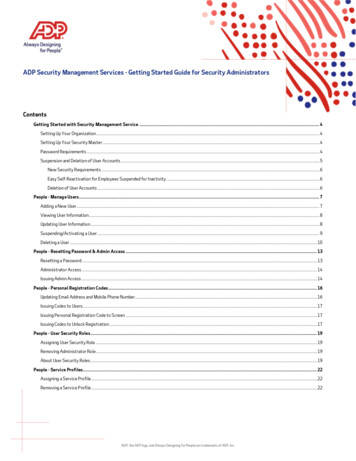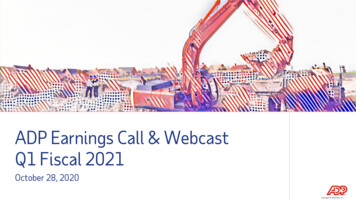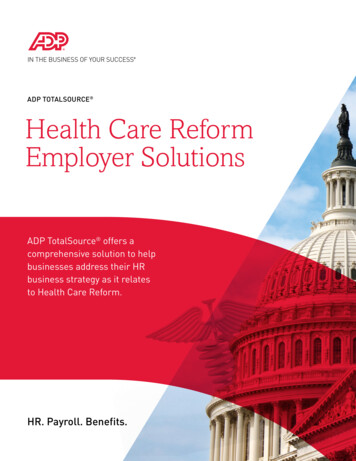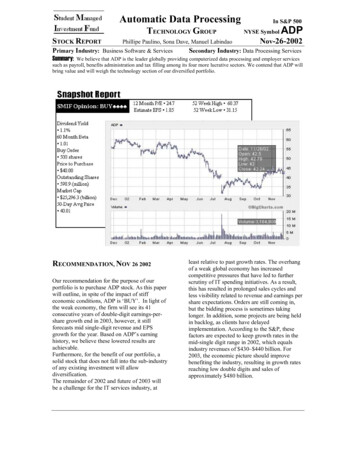
Transcription
Automatic Data ProcessingTECHNOLOGY GROUPSTOCK REPORTPhillipe Paulino, Sona Dave, Manuel LabindaoIn S&P 500NYSE SymbolADPNov-26-2002Primary Industry: Business Software & ServicesSecondary Industry: Data Processing ServicesSummary: We believe that ADP is the leader globally providing computerized data processing and employer servicessuch as payroll, benefits administration and tax filling among its four more lucrative sectors. We contend that ADP willbring value and will weigh the technology section of our diversified portfolio.RECOMMENDATION, NOV 26 2002Our recommendation for the purpose of ourportfolio is to purchase ADP stock. As this paperwill outline, in spite of the impact of stiffeconomic conditions, ADP is ‘BUY’. In light ofthe weak economy, the firm will see its 41consecutive years of double-digit earnings-pershare growth end in 2003, however, it stillforecasts mid single-digit revenue and EPSgrowth for the year. Based on ADP’s earninghistory, we believe these lowered results areachievable.Furthermore, for the benefit of our portfolio, asolid stock that does not fall into the sub-industryof any existing investment will allowdiversification.The remainder of 2002 and future of 2003 willbe a challenge for the IT services industry, atleast relative to past growth rates. The overhangof a weak global economy has increasedcompetitive pressures that have led to furtherscrutiny of IT spending initiatives. As a result,this has resulted in prolonged sales cycles andless visibility related to revenue and earnings pershare expectations. Orders are still coming in,but the bidding process is sometimes takinglonger. In addition, some projects are being heldin backlog, as clients have delayedimplementation. According to the S&P, thesefactors are expected to keep growth rates in themid-single digit range in 2002, which equalsindustry revenues of 430– 440 billion. For2003, the economic picture should improvebenefiting the industry, resulting in growth ratesreaching low double digits and sales ofapproximately 480 billion.
TECHNOLOGY GROUPSTOCK REPORTAutomated Data ProcessingNYSE SymbolADPBUSINESS SUMMARY, NOV 26 2002ADP is the largest computing servicescompanies in the US (and one of the largestworldwide), providing a wide range of dataprocessing services. It is broken down into fourbusiness segments: employer, brokerage, dealerand claims.The employer services unit, accounting for 60%of revenues, is the leading world provider ofpayroll, processing paychecks of over 30 millionemployees. It is also the leading provider ofhuman resources services; including benefitsadministration, time and attendance, tax filingand reporting services. Its client base consists of455,000 customers in the US, Canada, Europeand Latin America. ADP is the second largestProfessional Employer Organization (PEO),providing a bundled outsourcing solutionincluding the services mentioned. The marketdrivers for this segment are interest rates, theunemployment rate, internal growth and mergersand acquisitions.truck dealer clients and more than 30 vehiclemanufacturers. These customers use theircommunication networks and on-site systems tomanage sales and operations. Major trendswithin this division have been industryconsolidation, Internet auto purchases, stillcompetition and slow growth.The claims services segment is a leadinginternational provider of claims information tothe property and casualty insurance industryserving more than 20,000 clients. It offers abroad line of products to aid insurance adjusters,collision repair shops and auto part recyclingfacilities in accurately estimating auto damage,bodily injury and property claimsINDUSTRY OVERVIEW, NOV 26 2002The Data Processing industry can be linked tomultiple sectors, and is most often associatedwith the High Technology or the IndustrialServices industries. A positive aspect of the DataProcessing industry is that it is not too dependenton its Technology counterpart. In light of theplunge in tech-stocks and the risk associatedwith companies’ unreliable practices, dataprocessors have enjoyed a defensive position inthe market. Investors feel comfortable pouringmoney into data processing firms because theydo not involve an unseasoned business model.Furthermore, their valuations are solid anddependable.TRENDS, NOV 26 2002The brokerage services unit, accounting for 25%of revenues, is the leading provider of securitiestransaction processing applications, brokerdesktop productivity applications and investorcommunications services to the financial servicesindustry worldwide. On average they process 1.3million trades per day, and 780 millionshareholder mailings. Over the past 30 years,there has been a 15% growth in trades, and a30% growth in the past 5 years. Their key clientsare Paine Webber, Quick & Reilly, CharlesSchwab, Legg Mason and Lehman Brothers.The dealer services division is the leadingprovider of transaction systems, data products,and professional services to over 16,000 auto andTwo significant trends which data processorsdepend on are outsourcing and e-commerce.Most data processors experience recurringrevenues due to the constant outsourcing frombusiness that are looking to cut costs associatedwith in house systems. By outsourcing theportion of the business to data processors thathave the technology and means to complete thetask, companies can lower costs and focus ontheir core products and services. To illustrate,IBM may outsource its payroll functions to adata (payroll) processor such as ADP.Short-term growth for this industry has beenimpeded by economic conditions; however theneed to cut costs and increase efficiency hasresulted in a continuous demand for outsourcing.
TECHNOLOGY GROUPSTOCK REPORTAutomated Data ProcessingNYSE SymbolADPINTENSIVE COMPETITIVE ANALYSIS,NOV 26 2002There are times at which competition results inbeing so aggressive that companies tend to losemarket share and profit margins. In the case ofADP, it kind of hard to pin point which is itsstronger archrival because it is so welldiversified in so many different sectors of theindustry that per each sector, a competitor arises.This is the case with PAYCHEX, the mostdominant payroll processor in the United States.If it measures against ADP, Paycheck will seemextremely powerful in that sector of the industrybecause Paycheck specialized on this niche ofthe market. Nevertheless, a large share of thismarket is still up for grabs so ADP has stillplenty of growth potential. Competitors thatresemble ADP in its operations and services arefew and First Data Corp. is the biggest one.the creation of the Net unlike BEA which liveson it.IMS Health (RX) is practically not even close toADP’s standards but on account of its salesmanagement services and information solutionwhich ADP partially touches to provideadditional revenues for its operations, RX isconsidered another competitor. IMS Healthcustomers are exclusively drug companies andother companies in the health care industry. Itsnucleus operations are intended to provide itscustomers with market research report,professional development and research anddevelopment services. The only service that RXoffers and intertwines with ADP’s business is itsventure capital unit that deals with InformationTechnology and software development for ebusiness. Those units are still in a process ofsurvival and barely hurt ADP’s bottom line.Worldwide IT Spending Forecastin billions of dollars700Se rvices600Ha rdw a re500In billionsPacka ge d Softw are40030020010002001It is possible to contend that the diversificationof ADP in the industry is such that the main coreproducts of its competitors are as follows.Bea Systems basically leads in the applicationinfrastructure provider sector of the industry withonly 13,000 customers including Citigroup,NASA and Wells Fargo. Its product is used inmainframe to support transaction processing,billing and customer services capabilities.It is necessary to keep in mind that Bea dependson the Internet to succeed that the reason it wasone of the few dotcom companies that overcomethe debacle. Bea benefits from the buildout ofInternet infrastructure that is required for someapplications such as JAVA. In the case of ADP,its operations are not contingent on the Internetbecause this payroll processor utilizes as a meanand not the end. ADP was founded way before2002200320042005The Business Software Industry has a lot ofpotential in the Technology market becauserelatively new and few players are capable ofgetting their feet wet with some profits. Manyanalysts on Wall Street have forecasted thatwhile the Hardware sector will be pulling back inspending, Services and the Packaged Softwaresector will spend much more in new technology.Nevertheless, Services will outgrow in spendingin the next upcoming three years, making muchclearer that a rebound in the sector will occur.When that rebound occurs, ADP will be the firstone benefiting from it.The newest competitor in such market is BeaSystem Inc., which went public on 1995 at thevery beginning of the dotcom bubble. Thiscompany has a lot of growth prospective over thenext 5 years but it doesn’t seem to outperformthe overall competition until then.
TECHNOLOGY GROUPSTOCK REPORTAutomated Data ProcessingHowever, let’s digress from Bea Systems and goback to FDC because there are some areas inwhich this player is ahead of ADP.When we scrutinize thoroughly this company’sfuture, we happen to see that FDC has a brighterfuture than ADP when long term growth andrelative strength is concerned. Perhaps, the stockis viewed by investors a well-priced having intoconsideration the rate of relative risk it holds.The ROE for FDC is way higher than ADP andcorroborates how profitable is the companywhen it efficiently uses its investors' money.First Data Corp.’s bread and butter is essentiallyPayment Services, which is the opposite of ADP,Employee Services. Payments Services arecomprised of one main champion of all titans,Western Union. Western Union International hasalmost doubled its profits this year. In otherwords, while ADP deals with payroll checks,First Data Corp. handles independent moneyorders. They practically collide in the DataProcessing business because First Data Corp. isthe largest provider of credit and debit cardtransaction processing services in the US. FDCgot the leadership in such business afteracquiring NYCE or best known as ATMnetworks. ADP doesn’t even lay a hand on thatbusiness because it is pretty saturated withConcord EFS which is the backbone company ofthe government’s food stamp and Fiserv, whichwill be bringing into the spotlight now.Fiserv’s main business is processing financialtransaction, which s already dominated by ADP.If ADP has gotten hurt by the lost of business inthe financial industry just think about Fiserv,whose market share is merely a 8.9%. Thiscompany also provides e-commerce technologysolutions, ATM and debit card processing andelectronic transfers. FISV is obviously wellNYSE SymbolADPdiversified in the industry but it doesn’t have anyleadership, thus, it doesn’t meet the prerequisitesto be compared against other leaders such asADP and FDC when we talk about healthy cashflows. As we can observe ADP’s competition isserving other customers, ranging from healthcare and Internet-based companies to ATM usersand money orders buyers. None of thesecustomers ADP services at least directly.The relative strength for FDC is also pretty highwhen it is compared to ADP. Relative Strength isthe stock's price movement, compared to thechange in a relevant market index, such as theS&P 500. The typical timeframe is 12 months.Momentum investors like to buy stocks withhigh relative strength because they believe astock that has a strong P/E rating will continue tomove higher. The strategy has worked well inbull market, but it is a high-risk approachbecause these stocks are also likely to fall hardwhen the market tumbles. In other words, theFDC stock has a bullish trend compared to ADP.As we can see in the above graph, FDC stockhasn’t gone below the S&P 500 trend on a yearbasis. It is trading way above the marketexpectations and it has outperformed ADP byfar. ADP and the S&P 500 are trading below15% while FDC is 15% above from them.Perhaps, the FDC stock is riskier because basedon its beta; it is the highest after Bea Systems.Finally, let’s take a look at the PEG ratio whichoffers a more efficient gauge of growth than theP/E ratio. The PEG ratio is an accurate indicatorof determining whether a stock is undervalued orovervalued but also accounting for growth.
TECHNOLOGY GROUPSTOCK REPORTAutomated Data ProcessingOne interpretation of this PEG ratio being greaterthan 1 (a fairly valued stock would have a PEGratio of 1) is that the stock retains its "growth"classification, despite the recent bad newssurrounding ADP, because it is still expected tooutperform the rest of the market. It could alsomean that the stock is overvalued and that themarket expects future EPS growth to be greaterthan what is currently in the Street consensusnumber. ADP’s latest EPS is 1.75 and threeyear from now will be 2.03. Growth stocks,such as ADP, typically have a PEG ratio greaterthan 1 because investors are willing to pay morefor a stock that is expected to grow rapidly.SWOT ANALYSIS, NOV 26 2002Strengths and Opportunities ADP is amazingly profitable. It generatedmore than 1 billion of free cash flow in fiscal2002, thanks to low capital-spending needsand high operating margins. The company is the model of consistencyhaving delivered an unprecedented string of164 consecutive quarters of record sales andearnings, and 41 straight years of double digitEPS growth. ADP has strong fundamentals with significantrecurring revenues, notable operationalleverage, a strong balance sheet, little debt,and strong cash flows. The firm is using its substantial free cash flowto repurchase shares to boost stock price. Strategic acquisitions may add to thecompany’s business and strengthen itscompetitive position. ADP has plenty of opportunities for growthdue to firms increasing use of outsourcing. ADP's businesses have substantial barriers toentry, limiting competitive threats.NYSE SymbolADPWeakness and Threats Revenue growth was lower than targeted in2002, and the firm expects only single-digitgrowth in 2003. This is below ADP's historicalperformance. ADP operates in a tough environment, wherecompetition in ADP's core payroll-processingniche seems to be heating up. Credit/debit cards are increasingly displacingcash/checks in payment stream for employers. Lower interest rates will further pressureinterest income earned on the float of clientand corporate funds, pressuring both revenueand corporate interest income. Near term declines in employment followed bya more prolonged recovery period will meanfewer checks to process per client, weakeningboth core payroll revenue growth and HRprocessing fees. Payroll processors continue to be impacted bythe weak economic environment anduncertainty regarding the pace of recovery.VALUATION, NOV 26 2002Since ADP has been negatively affected by theeconomic slowdown, it is expected to generateannual earnings growth in the mid to high singledigits over the short term as opposed to thedouble digit gains that they have beenhistorically known for. They have also beenpracticing a strong corporate strategy bycontinuing to acquire businesses to strengthentheir competitive position and increase marketshare. Growth in payroll is expected to be inmid-single digits despite their huge base of morethan 455,000 clients. However, the market forpayroll outsourcing is still relatively untapped,thus representing opportunities for growth
TECHNOLOGY GROUPSTOCK REPORTPROFITABILITYAutomated Data ProcessingNYSE SymbolADPcan tell whether the company is operating moreefficiently than its rivals. Profit ratios over timeindicate whether a company’s performance isimproving or declining.RATIOSmeasure howefficiently the company uses its resources. Themore efficient the company, the greater itsprofitability. By comparing a company’sprofitability against its major competitors, youGross Profit Margin:2001: (Sales Revenue – Cost of Goods Sold) / (Sales Revenue) (6,853,652-2,970,645) / (6,853,652)2002: (Sales Revenue – Cost of Goods Sold) / (Sales Revenue) (7,004,263-2,900,124) / (7,004,263)YEAR20012002GROSS PROFIT MARGINADPSales Revenue - COGS57.7%Sales RevenueGross profit margin indicates how efficiently acompany manages its largest assets and greatestcosts. A company that boasts a higher GPM thanits competitors and industry is more efficient. Itshows the percentage of net sales remaining aftersubtracting cost of goods sold. This means thatfor every 1 in sales revenue, ADP needs 0.58,to cover its costs. (58% Sales cover expenses)This is good because it indicates that a greater %of their revenues are being used to cover costs.ADP’s GPM is greater than the industry, whichindicates it is more efficient in the productionand distribution of its product than most of itscompetitors. This can be explained by theirability to achieve record earnings, revenues andcash generation in 2002.INDUSTRYADPINDUSTRY32.9%57.6%35.7%Even though their GPM is better then theirindustry, revenue growth slowed to 2% growthas compared to 11% growth in 2001. This wasdue to weakened economic conditions affectingADP’s Brokerage and Employer services.Discretionary spending and new investmentsdeclined in Brokerage services because ofsoftness in the Financial Services industry. Thedecline in Employer Services was the result ofweakened economic conditions causing lowerclient retention (because of bankruptcies), slowersales, and fewer employees for payrolls. Thetrend of declining interest rates the past twoyears also had a major impact on their interestearnings from client funds. (See revenue growthtable)Net Profit Margin:2001: (Net Income / Sales Revenue) (924,720 / 6,853,652)2002: (Net Income / Sales Revenue) (1,100,770 / 7,004,263)2001YEAR2002NET PROFIT MARGINADPINDUSTRYADPINDUSTRYNet IncomeSales Revenue13.5%(2.8%)15.7%(11.9%)Net profit margin tells you how much profit acompany makes for every 1 it generates inrevenue. This basically means that Steve Maddenmakes 13.5 cents profit from every dollar ofrevenue. Net profit margin measures the abilityto earn a return after meeting interest and taxobligations. The company’s Net Profit Margin ismore than the industry average meaning thatADP has a better ability to earn returns than theircompetitors and survive in the long run.Once again, this increase can be explained bytheir 2% revenue growth despite a negativeindustry environment. The increase can also beattributed to a series of cost-cutting initiativesthe company has been instituting to survive inthe weak economy. The increase can also be theresult of ADP adopting new accounting practiceswhich required that goodwill no longer beamortized in the balance sheet (SFAS 142)i,which decreased their amortization expense. Intheir 2002 annual assessment, ADP indicated noimpairment of goodwill.
TECHNOLOGY GROUPSTOCK REPORTAutomated Data ProcessingNYSE SymbolADPReturn on Total Assets:2001: (Net Income Avail. to Com. Stockholders / Total Assets) (924,720 / 17,899,090)2002: (Net Income Avail. to Com. Stockholders / Total Assets) (1,100,770 / 18,276,522)2001YEAR2002RET. ON TOTAL ASSETSADPINDUSTRYADPINDUSTRYNet Income CommonTotal Assets5.2%(1.9%)6.0%(9.4)%structure, they have been able to saveapproximately 100 million in lower annualexpenses as of June 30, 2002. In 2001, they wereable to reduce expenses by 150 million. ADPwas able to cut costs while continuing to increaseoverall efficiency and productivity. ADP has alsobeen continuing to pursue several promisingopportunities which are based mainly in new andimproved products and services. These measurescan increase asset-use efficiency even further.The negative industry numbers indicate that theircompetitors are having a tough time
STOCK REPORT Automated Data Processing NYSE Symbol ADP BUSINESS SUMMARY, NOV 26 2002 ADP is the largest computing services . Quick & Reilly, Charles Schwab, Legg Mason and Lehman Brothers. . the g


